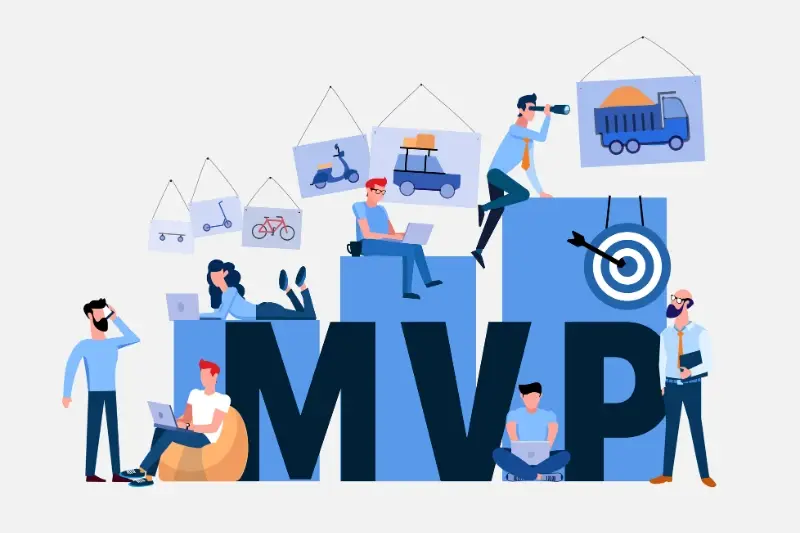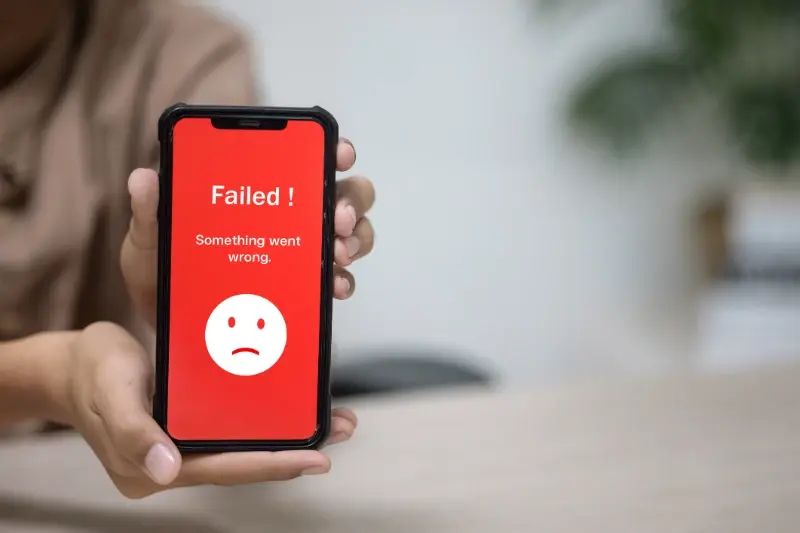Nine out of ten startups fail within their first year—and most of them had what seemed like brilliant ideas. The problem wasn't their vision or their passion; it was how they built their minimum viable product. I've watched countless entrepreneurs pour their life savings into MVP development, only to see their dreams crumble because of avoidable mistakes that could have been spotted from miles away.
The MVP approach was supposed to make startup life easier. Get something basic out there, test it with real users, then improve based on what you learn. Simple, right? Yet somehow, this straightforward concept has become one of the biggest stumbling blocks for new businesses. Founders either build too much too soon, or they skip the validation steps that matter most.
The goal of an MVP isn't to build the perfect product—it's to learn the most about your customers with the least amount of effort
After working with hundreds of startups over the years, I've noticed the same development errors and product pitfalls appearing again and again. The good news? These startup failures follow predictable patterns, which means they're completely preventable once you know what to look for. Let's explore the biggest MVP mistakes that are killing promising startups—and more importantly, how you can avoid them.
Building Too Many Features From Day One
I see this mistake all the time—founders who think their MVP needs to do everything their final product will do, just smaller. That's not what an MVP is about at all! The whole point is to test your core idea with the minimum set of features needed to prove it works.
When you pack too many features into your first version, you're basically shooting yourself in the foot. You'll spend months (or even years) building something that might not even solve the right problem. I've worked with startups who spent their entire budget on a feature-heavy MVP that nobody wanted to use.
The Real Cost of Feature Creep
More features don't just mean more development time—they mean more complexity, more bugs, and more things that can go wrong. Your users will be confused about what your app actually does, and you'll struggle to get meaningful feedback because there's too much noise.
Here's what happens when you focus on your core features instead:
- Faster time to market
- Lower development costs
- Clearer user feedback
- Easier to pivot if needed
- Better user experience
Start with one thing that solves one problem really well. You can always add more features later once you've proven people actually want what you're building.
Skipping User Research and Market Validation
Here's something I see time and time again—founders who fall so in love with their idea that they skip the most basic step of all: actually talking to real people about it. I get it, you're excited about your brilliant concept and want to start building straight away. But here's the thing: your opinion doesn't matter nearly as much as you think it does.
When we work with clients at Glance, one of the first questions we ask is "who have you spoken to about this?" You'd be surprised how many times the answer is "well, my mum thinks it's great" or "my mates down the pub love the idea." That's not market validation—that's just people being polite!
Real user research means getting out there and having proper conversations with the people who might actually use your product. Not your friends, not your family, but strangers who have the problem you're trying to solve.
What Proper Market Validation Looks Like
Market validation isn't about asking people if they like your idea—it's about understanding their current behaviour and pain points. Here's what you should be doing:
- Interview at least 20-30 potential users about their current problems
- Observe how they currently solve these problems
- Test your assumptions with real data, not gut feelings
- Look at what competitors are doing and why they might be failing
- Run small experiments before building anything major
Start with problem validation before solution validation. Make sure people actually have the problem you think they have, and that it's painful enough for them to want to pay for a solution.
The startups that succeed are the ones that build something people actually want—not something they think people should want. Skip this step and you're basically building in the dark.
Choosing the Wrong Technology Stack
I've seen plenty of startups get excited about using the latest, shiniest technology for their MVP—and then watch their whole project collapse because of it. The technology stack you choose isn't just about what looks impressive on paper; it's about what actually works for your specific situation, budget, and timeline.
Here's the thing: your MVP doesn't need to be built with cutting-edge technology that only three developers in the world understand. It needs to be built with something reliable, well-documented, and accessible to your team. I've worked with clients who insisted on using brand-new frameworks that had barely any community support, only to find themselves stuck when bugs appeared and there was no help available online.
Common Technology Stack Mistakes
- Choosing trendy but unstable frameworks with limited documentation
- Overcomplicating the architecture when simple solutions would work
- Picking technologies your team doesn't understand properly
- Ignoring scalability requirements for future growth
- Selecting tools that don't integrate well together
The best technology stack for your MVP is often the boring one—the one your developers know inside and out, that has excellent community support, and that can handle your current needs without breaking the bank. Save the experimental tech for version two when you've got users and revenue to support those risks.
Perfectionism Over Speed to Market
I've seen this MVP mistake destroy more startups than almost any other—spending months polishing features that users might not even want. Perfectionism feels safe, but it's actually one of the riskiest approaches you can take with your minimum viable product.
The whole point of an MVP is to test your core idea quickly and cheaply. When you spend six months perfecting animations, tweaking colour schemes, and building elaborate onboarding flows, you're missing the point entirely. Your users don't care if your app looks like it belongs in a design museum; they care whether it solves their problem.
The market doesn't wait for perfection—it rewards speed and adaptation
What makes this mistake so dangerous is that whilst you're busy perfecting your app, your competitors are already in the market learning from real users. They're discovering what works, what doesn't, and what users actually need. Meanwhile, you're still debating whether that button should be blue or green.
Launch First, Perfect Later
The best approach? Ship something that works—even if it's not pretty. Get real user feedback. Then improve based on what you learn. I've worked with countless startups who launched "imperfect" MVPs and went on to build successful products. The ones who waited for perfection? Most never launched at all.
Ignoring User Feedback After Launch
I've worked with countless startups over the years, and there's one mistake that makes me want to pull my hair out—launching an MVP and then pretending user feedback doesn't exist. It's like asking someone for directions and then walking the opposite way!
Your users are telling you exactly what they want. They're leaving reviews, sending emails, and probably screaming into the void about what's broken or missing. But here's what happens: founders get so excited about their "finished" product that they forget the MVP is just the beginning of the conversation, not the end.
Common Feedback Avoidance Patterns
Most teams fall into these traps after launch:
- Only reading positive reviews and ignoring the negative ones
- Assuming users "just don't get it" when they struggle with features
- Planning the next big feature instead of fixing current problems
- Waiting for "enough" feedback before making any changes
- Treating criticism as personal attacks rather than valuable insights
The smartest founders I know treat their first users like gold. They respond to every piece of feedback—even the harsh stuff. They set up proper channels for collecting input and actually act on what they learn. Your MVP isn't a finished product; it's a learning tool that should evolve based on real user behaviour.
Poor Team Communication and Planning
I've watched countless MVP projects fall apart—not because of technical issues or bad ideas, but because the team couldn't talk to each other properly. It sounds simple, but you'd be surprised how many startups skip the basics of keeping everyone on the same page.
When your designer thinks the app needs five screens and your developer assumes it's three, you're heading for trouble. I've seen teams spend weeks building features that were never actually agreed upon, simply because nobody bothered to write things down or have a proper planning session.
The Planning Problem
Most startup teams are small and scrappy, which can be brilliant for moving fast. But it can also mean people assume they don't need formal planning processes. Wrong! Even a two-person team needs clear timelines, defined roles, and regular check-ins.
The biggest communication failures happen when technical and non-technical team members don't speak the same language. Your marketing person might think "simple login" means something completely different to your developer—and that misunderstanding can cost you days of work.
Set up a weekly planning meeting where everyone explains what they're working on in plain English. Use project management tools like Trello or Asana to keep tasks visible to the whole team.
Good communication isn't just about avoiding mistakes; it's about building an MVP that actually reflects your shared vision rather than everyone's individual interpretation of it.
Underestimating Time and Budget Requirements
I've lost count of how many times I've sat across from a founder who's convinced their MVP will take "just a few weeks" and cost "maybe a couple of thousand pounds." The optimism is admirable, but the reality check that follows can be brutal. Building an MVP always takes longer and costs more than you think—even when you think you've accounted for that fact!
The problem isn't just wishful thinking. Most people genuinely don't understand what goes into building even a simple app. You're not just paying for the visible features users will see; you're paying for user authentication, data storage, security measures, testing across different devices, app store submissions, and dozens of other behind-the-scenes elements that make everything work properly.
Common Budget Blind Spots
- Third-party service integrations and monthly fees
- App store developer accounts and submission costs
- Device testing on multiple screen sizes and operating systems
- Security audits and data protection compliance
- Post-launch bug fixes and immediate updates
- Server hosting and database management costs
Here's what I tell every client: double your time estimate and add 30% to your budget. Seriously. That's not pessimism talking—that's eight years of experience watching brilliant ideas struggle because they ran out of money before reaching the finish line.
Conclusion
Building a successful minimum viable product isn't rocket science, but it does require discipline and a willingness to make some tough choices. I've seen countless startups fail because they tried to build everything at once, ignored what their users actually wanted, or got so caught up in making things perfect that they never actually launched. The truth is, most MVP mistakes come down to one simple problem—teams forgetting that the whole point is to learn, not to impress.
The startups that succeed are the ones that embrace the messy, imperfect nature of early-stage development. They ship quickly, listen carefully to feedback, and aren't afraid to pivot when something isn't working. They understand that an MVP isn't meant to be your final product—it's meant to be your first step towards understanding what your final product should actually be.
So before you start building, take a step back and ask yourself: what's the smallest thing we can create that will help us learn something meaningful about our users? Start there, ship it, and then let your users guide you towards what comes next. Trust me, they'll tell you exactly what they need if you're willing to listen.
Share this
Subscribe To Our Blog
You May Also Like
These Related Stories

The Complete Guide to Building Your First Mobile App MVP in 2025

Startup App Development: How To Build An Mvp Without Going Broke





